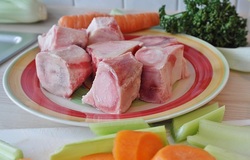
It has only been over the past couple of generations that bone broth has started to disappear from the American diet, and its recent resurgence in popularity is more due to the natural health foods movement of the past few years than to any familiarity with the subject. In fact, most people my age think of bone broth as nothing but a strange health fad, though it is certainly nothing new to me!
Growing up on the farm, we were schooled in the importance of using the whole animal, not wasting precious food, and extracting as many nutrients as possible out of the food we raised and grew. You could call these ancient "traditions" of sorts, but they stem from times when food was more scarce, and resources were much harder to come by than they are for many Americans today. Those who may have grown up in households of very modest means may be familiar with these philosophies, but otherwise, making your own bone broth may sound rather strange to you.
If it does, I encourage you to learn a bit more about why bone broth might be a healthy addition to your diet, as well as a sustainable food source. Below are some facts about bone broth, plus an easy and nutritious recipe to try.
1.) Recent research suggests that bone broth has some minerals, but it probably isn’t a mineral miracle (1). Eating lots of leafy greens is a better way to up your mineral intake.
2.) Bone broth most certainly contains lots of protein and amino acids that our bodies need (2), (3) and as such is a great way to get more protein and calories out of the animals we already raise for meat.
3.) Long-boiled bone broth can be an awesome source of gelatin, and there is a good amount of evidence to suggest that gelatin has positive benefits on joint, liver, intestinal, and even mental health. (4)
Back in the days when people either raised or hunted their own meat (or went without), they would never dream of throwing out all the bones, cartilage, fat scraps, and organ meats - in fact, in some traditional societies, the organ meats were highly prized as the best part of the animal (likely due to their high nutritional value, plus their relative scarcity compared to the bulk of the animal). These days, it is nearly impossible to find any of these items at the grocery store - yes, even bones.
If you eat meat, commit to sourcing responsibly raised meats, and eating as much of the animal as possible. Buying "choice cuts" at the supermarket is just plain wasteful and irresponsible in my opinion - especially considering the horrendous conditions of today's factory farms.
Which reminds me - before I share how to make your own bone broth (it's super easy by the way, though it does take some cooking time) - I want to caution you about selecting your broth bones. Bones can be a place where the body stores certain toxins, and animals are no exception. I would think twice before making bone broth from the bones of conventionally raised (factory farmed) animals. While not everyone can afford organic or grass-fed meats, and I admit to using store-bought bones in the past, myself, in general, the broth made from these bones will not be as nutritious or as good for you as if using bones from healthy animals raised on pasture. But then again, if you are eating conventionally raised meats anyway, using the bones likely isn't much worse for you than eating the meat, and you will still get some nutritional value that you would otherwise be missing out on, as well as reducing the aforementioned waste. Still, I would try to minimize your use of bones (and meat) from industrially farmed animals if at all possible.
To make your bone broth, you will want to gather not only bones, but also joints, cartilage, skin, and any fatty bits of the animal you aren't going to eat. If you process your own animals, you can also add things like heads, feet, and organs. (Chicken feet make absolutely AMAZING gorgeous, rich, and yellow broth!)
Just about any type of animal bones will do - it doesn't matter if they are poultry, beef, pork, wild game, or even fish. You can keep the different types separate, or mix them for a more rounded set of flavors. Roasting the bones first adds an additional depth of flavor, but raw bones also work just fine - as do cooked bones left over from a roast or other meal.
Since it takes a long time to cook a pot of bone broth, you will likely want to save up bones from several meals until you have enough to make a big batch. Just put your leftover bones and other stuff in a large bag and store in the freezer - adding to it until you are ready to make your broth.
Here is my favorite way to make bone broth, courtesy of TheGrowNetwork.com:
- Once you’ve assembled a collection of bones to fill about half the pot you intend to cook them in, put them in a pot and fill the rest of the pot with water. Add some vinegar (about a tablespoon per quart of water). (This helps pull calcium and other nutrients out of the bones and into the broth.)
- At this point, some people add stuff like onions, carrots, mushrooms, and herbs to the pot. Logically, since there is a nutritional benefit to vegetable stock, by doing this you are making both vegetable and meat stock at once and hence increasing the nutritional content. Personally, I don’t bother, because I like to add my vegetables directly to the meals I make with my stock and eat them whole. But either way is fine. To veggie or not to veggie up your bone broth is entirely up to you.
- Boil.
- To extract high quantities of goodness from bones, you will need to boil them for 8–24 hours. (Longer cooking will extract more nutrients from the bones. However, you can have good bone broth in as little as 8 hours, so cook them as long as you can - just make sure they go for at least 8 hours.)
- You can use a stock pot, pressure cooker, slow cooker, or solar cooker. You can even make it in the oven. Pressure cookers break down bones faster and use less energy to produce the same results than other non-solar options. Solar cooking requires at least two good sunny days and a solar cooker large enough to accommodate a worthwhile amount of broth (or the patience to make small quantities of stock frequently).
- If you are not using a pressure cooker, you will likely have to add water to keep the bones covered at some point during this long cooking period. I normally turn my burner off while I sleep and fire it up again in the morning. This cuts down on fire hazards and ensures I don’t run out of water while I am not paying attention to the pot.
- To extract high quantities of goodness from bones, you will need to boil them for 8–24 hours. (Longer cooking will extract more nutrients from the bones. However, you can have good bone broth in as little as 8 hours, so cook them as long as you can - just make sure they go for at least 8 hours.)
- Once you are done boiling, take the lid off for a little bit and let some of the liquid cook off. Your liquid line should be about halfway up your pot, or the same height the bones were when you first started cooking them.
- Then, use a sieve and strain out the bones. You can also run your liquid through a cloth napkin or flour sack if you want to remove all bits and traces of meat.
Cool your bone broth, and store it in the refrigerator for up to a week, or pour into freezer-safe containers and freeze for future use - it will keep just fine for several months.
What to do with your leftover bones? They should be somewhat soft when you're done, so you can feed them to pets if you like, or you can also compost them.
How to Use Your Bone Broth:
You can use bone broth whenever you would use any other broth - but since it is concentrated, for soups cut the bone broth with water. You can also add it to many recipes for extra richness, flavor, and nutrition.
Here are a few tasty ways to enjoy your bone broth:
- Add a few spoonfuls when sauteing or roasting vegetables.
- Use half bone broth and half water when cooking legumes such as lentils, beans, or peas.
- Use 25% bone broth and 75% water when cooking rice, quinoa, or other grains.
- Use 75% bone broth and 25% water when making any vegetable-based soup or stew.
- Substitute 50% bone broth for half the liquid in savory batters such as cornbread.
- Use bone broth as the base for gravy, sauces, and pot pie fillings.
- Mix half a cup of bone broth with half a cup of hot water, add salt to taste, and sip when you're feeling under the weather for a warming, comforting, and nutritious treat for your body!
On a final note, you may be wondering, but can't you just buy bone broth? Why yes, you can; however, I wouldn't recommend it. For one thing, do you really know the source of those bones? Secondly, the "bone broth" you buy at the store has little similarity to the richness, deliciousness, and nutrition of the kind you can make, yourself.
Just so you know what to expect from good bone broth, when cold, it should have the consistency of jelly. (This is due to the collagen that is extracted from the bones during the cooking process.) Depending on the bones (and other ingredients) you use, it may be a buttery yellow to a rich brown color. If you place a spoonful of it in a hot pan, it melts like butter. It has a rich, mellow, and earthy flavor, which varies depending on the bone type and other ingredients you use.
If you eat meat, adding bone broth to your diet is a great way to add extra nutrients, reduce waste, and eat more sustainably by making the most of the animal resources you consume.
To your health,
Rose.



 RSS Feed
RSS Feed